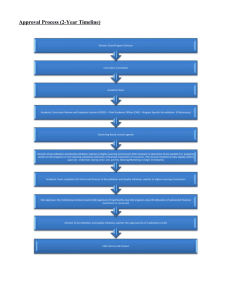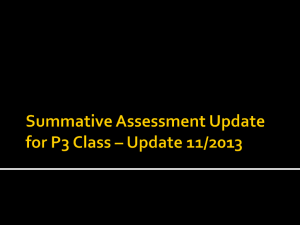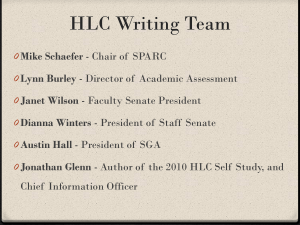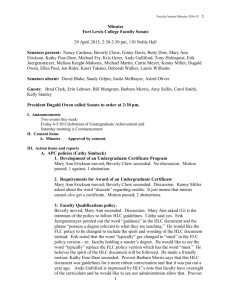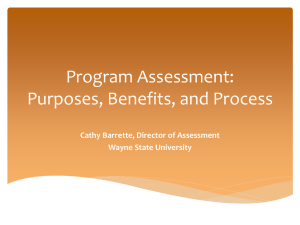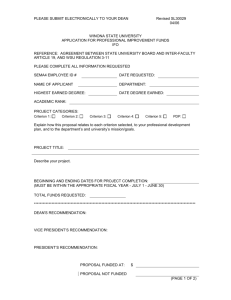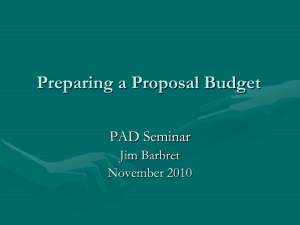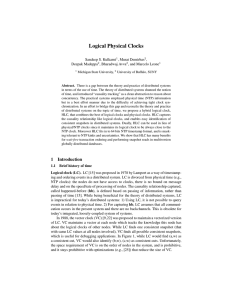HLC Grant Application Form
advertisement
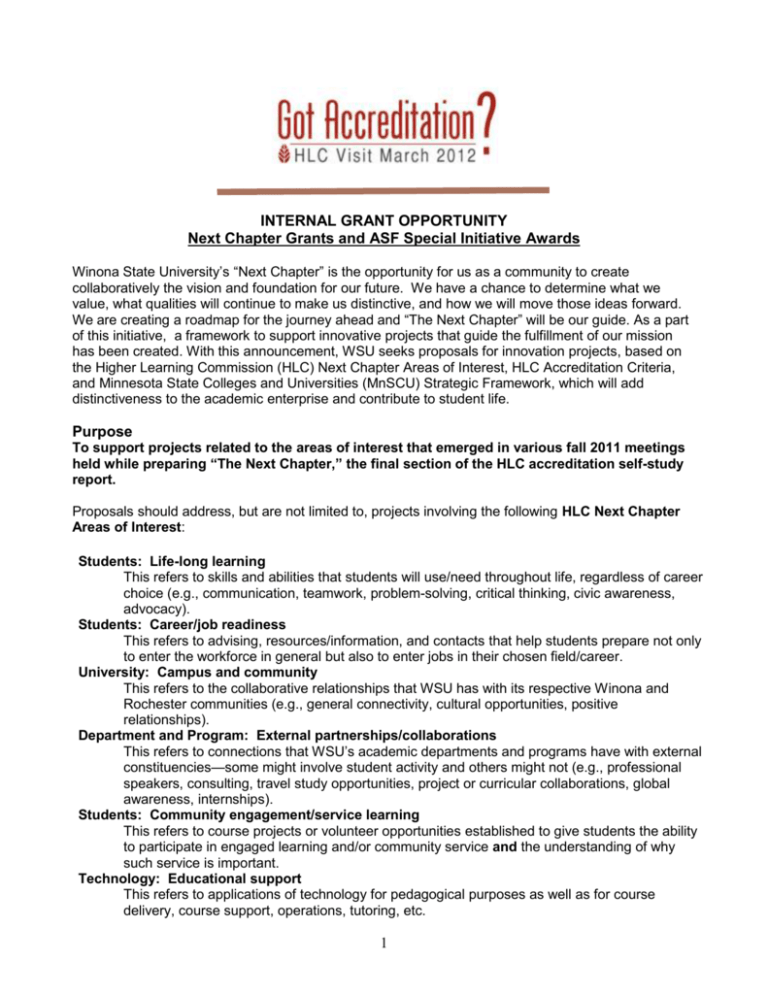
INTERNAL GRANT OPPORTUNITY Next Chapter Grants and ASF Special Initiative Awards Winona State University’s “Next Chapter” is the opportunity for us as a community to create collaboratively the vision and foundation for our future. We have a chance to determine what we value, what qualities will continue to make us distinctive, and how we will move those ideas forward. We are creating a roadmap for the journey ahead and “The Next Chapter” will be our guide. As a part of this initiative, a framework to support innovative projects that guide the fulfillment of our mission has been created. With this announcement, WSU seeks proposals for innovation projects, based on the Higher Learning Commission (HLC) Next Chapter Areas of Interest, HLC Accreditation Criteria, and Minnesota State Colleges and Universities (MnSCU) Strategic Framework, which will add distinctiveness to the academic enterprise and contribute to student life. Purpose To support projects related to the areas of interest that emerged in various fall 2011 meetings held while preparing “The Next Chapter,” the final section of the HLC accreditation self-study report. Proposals should address, but are not limited to, projects involving the following HLC Next Chapter Areas of Interest: Students: Life-long learning This refers to skills and abilities that students will use/need throughout life, regardless of career choice (e.g., communication, teamwork, problem-solving, critical thinking, civic awareness, advocacy). Students: Career/job readiness This refers to advising, resources/information, and contacts that help students prepare not only to enter the workforce in general but also to enter jobs in their chosen field/career. University: Campus and community This refers to the collaborative relationships that WSU has with its respective Winona and Rochester communities (e.g., general connectivity, cultural opportunities, positive relationships). Department and Program: External partnerships/collaborations This refers to connections that WSU’s academic departments and programs have with external constituencies—some might involve student activity and others might not (e.g., professional speakers, consulting, travel study opportunities, project or curricular collaborations, global awareness, internships). Students: Community engagement/service learning This refers to course projects or volunteer opportunities established to give students the ability to participate in engaged learning and/or community service and the understanding of why such service is important. Technology: Educational support This refers to applications of technology for pedagogical purposes as well as for course delivery, course support, operations, tutoring, etc. 1 Students: Higher expectations This refers to any call for students to be held to higher standards of practice in the classroom and lab or other academic settings as well as higher standards of conduct within and outside the WSU community. Students: Leadership opportunities This refers to any program that does, or could, give students active practice in taking leadership roles and developing leadership skills (both within and outside the classroom). Outreach: Non-traditional students This refers to the growing need for WSU to recruit and better serve non-traditional students, as well as to support outreach programs already in place. Department and Program: Interdisciplinary This refers to the need to create and support programs, curricular offerings, and other ventures that involve multiple disciplines, programs, and departments. Projects should either support what is unique and effective at WSU, or create new points of distinction for us as a community of learners. The most powerful proposals will be those that find the intersections between and among areas of interests. Collaborative, cross-unit/department/college, and/or cross-disciplinary projects are encouraged. Requests to $15,000. Option 1 – Submitted by a team of 2-3 faculty, staff and/or students requesting funding of up Option 2 – Submitted by a team of 4 or more faculty, staff and/or students requesting funding of up to $30,000. (A very limited number of Option 2 grants will be awarded.) Note: For both options, student applicants must have a faculty or staff sponsor Allowable Expenditures Funds may be used for resource materials, summer duty days, student stipends, Special Initiative Awards (SIA) (available to only Administrative Service Faculty (ASF) members as per collective bargaining agreement), staff support, or other relevant expenses. Funds for salaries and stipends will not be released until the final reports are submitted and approved. Assistance Applicants are encouraged to contact various offices for assistance and advice in preparing applications, such as the Community Liaison office; Educational Improvement and Leadership; Grants & Sponsored Projects; Teaching, Learning & Technology Services (TLT); Institutional Planning, Assessment & Research (IPAR); Grants and Sponsored Projects (G&SP), and the Statistical Consulting Center. Reporting Requirements Awardees’ final reports are due Monday, June 28, 2013. All reports are to be submitted to Kenneth Janz, Associate Vice President for Academic Affairs and Chief Information Officer (CIO), kjanz@winona.edu. The final reports will include a narrative and financial report. The narrative in the final report should provide a substantive record of the accomplishments of the project including: activities conducted during the project; how you met the goals set forth in your proposal or; if goals were not met, what lessons were learned and some discussion on reasons the goals were not achieved. The final reports will be published on the HLC Next Chapter website. 2 Proposals All proposals must address each of the following criteria. If any criterion is missing, the proposal will not be considered. Point values shown will be used during the evaluation of the proposal. a. Rationale: An explanation of how this initiative will benefit the University and its mission, including connections to HLC Next Chapter Areas of Interest (on page 1), HLC Accreditation Criteria (on page 7), and/or MnSCU Strategic Framework (on page 7). (20 points) b. Distinctiveness/Adaptation: An explanation of what is innovative about this project and how it will make WSU distinctive or how the project could enhance the student experience or strengthen the University’s academic programs. This could be an adaptation of promising approaches or programs that have been initiated at Winona State University or elsewhere. (15 points) c. Goals: A list of measurable desired outcome(s). (15 points) d. Timeline: A list of project tasks and expected completion dates. (15 points) e. Assessment Plan: Plans for measuring the outcomes of the initiative and disseminating the results. (20 points) f. Sustainability: Plans for continuing this project after funding has ended. In this section please describe how the project will be incorporated into the on-going procedures and programs of the University. Some projects will lead to additional phases or stages. Please describe in this section of the proposal what potential next steps may exist for the project after completion of this initial round of funding. (15 points) Review Process Proposals will be reviewed by a sub-committee of the HLC that will invite/include representatives of constituency groups and members of the local community. Because of contractual requirements, proposals including ASF applicants who are requesting SIA awards will also be reviewed by the Special Initiative Award Committee. (See Regulation WSU 3-36.) Timetable Monday, April 2, 2012 – Proposal submitted electronically and signed cover sheet delivered to Kenneth Janz, Associate Vice President for Academic Affairs and CIO, kjanz@winona.edu, Information Technology Services, Somsen Hall 111 by 4:30:p.m. Monday, April 30, 2012 – Awardees notified 30 days after project completion or no later than Monday, June 28, 2013 – Final reports submitted to HLC Steering Committee and SIA Committee if appropriate. 3 Next Chapter Grant Application and ASF Special Initiative Awards Title of Project Applicant Name(s) Department Email Dates of From to Final report must be submitted by June 28, 2013 to allow for processing any payroll or Project stipends. Total Request NOTE: A narrative of no more than three pages should be attached and include: a. Rationale: An explanation of how this initiative will benefit the University and its mission, including connections to HLC Next Chapter Areas of Interest (on page 1), HLC Accreditation Criteria (on page 7), and/or MnSCU Strategic Framework (on page 7). (20 points) b. Distinctiveness/Adaptation: An explanation of what is innovative about this project and how it will make WSU distinctive or how the project could enhance the student experience or strengthen the University’s academic programs. This could be an adaptation of promising approaches or programs that have been initiated Winona Sate University or elsewhere. (15 points) c. Goals: A list of measurable desired outcome(s). (15 points) d. Timeline: A list of project tasks and expected completion dates. (15 points) e. Assessment Plan: Plans for measuring the outcomes of the initiative and disseminating the results. (20 points) f. Sustainability: Plans for continuing this project after funding has ended. In this section please describe how the project will be incorporated into the on-going procedures and programs of the University. In appropriate, some projects will lead to additional phases or stages. Please describe in this section of the proposal what potential next steps may exist for the project after completion of this initial round of funding. (15 points) After reviewing proposals, the HLC Grants Sub-Committee and/or the SIA Special Initiative Award Committee may make suggestions for improving the proposal prior to making an award. 4 Applicant Signature(s) ____________________________ _______________________________ ____________________________ _______________________________ ____________________________ _______________________________ _____________________________________________________________________ Dean or Supervisor: Date: (Signature) Dean’s or Supervisor’s Recommendation: ☐ Approved ☐ Do Not Approve ☐ Approve with Reservations (Please provide a rational for your reservations in comments section below) Comments: If proposal is cross unit/college Dean or Supervisor: Date: (Signature) Dean’s or Supervisor’s Recommendation: ☐ Approved Comments: ☐ ☐ Do Not Approve Approve with Reservations (Please provide a rational for your reservations in comments section below) Click here to enter text. Monday April 2, 2012, 4:30 p.m. Proposal submitted electronically and signed hard copy cover sheet delivered to: Kenneth Janz Associate Vice President for Academic Affairs and (CIO) Somsen Hall 111 (physical delivery of the signed routing sheet) kjanz@winona.edu (electronic delivery) 5 BUDGET Provide an explanation/justification for each line item for which funding is requested. Personnel – Individuals are limited to a maximum of $5,000 in compensation. For faculty, in the Compensation column enter the number of duty days. For ASF enter the amount of SIA award requested. For all others, explain how the compensation was calculated. Name Applicant status (Indicate, faculty, ASF. Other or Student) Compensation $ $ $ $ $ $ $ $ $ Travel – Explanation $ $ $ Conference Registration fee Ground travel - Explanation: miles @ $ Air fare – to Explanation: Lodging days @ $ Meals per day for days Other – Explanation $ Equipment - Explanation: $ Supplies - Explanation: $ Other - Explanation: $ TOTAL REQUESTED $ $ Comments or additional justification: 6 HLC Accreditation Criteria See http://www.ncahlc.org/download/Overview07.pdf for an HLC Institution Accreditation Overview. Criterion One: Mission and Integrity. The organization operates with integrity to ensure the fulfillment of its mission through structures and processes that involve the board, administration, faculty, staff, and students. Criterion Two: Preparing for the Future. The organization’s allocation of resources and its processes for evaluation and planning demonstrate its capacity to fulfill its mission, improve the quality of its education, and respond to future challenges and opportunities. Criterion Three: Student Learning and Effective Teaching. The organization provides evidence of student learning and teaching effectiveness that demonstrates it is fulfilling its educational mission. Criterion Four: Acquisition, Discovery, and Application of Knowledge. The organization promotes a life of learning for its faculty, administration, staff, and students by fostering and supporting inquiry, creativity, practice, and social responsibility in ways consistent with its mission. Criterion Five: Engagement and Service. As called for by its mission, the organization identifies its constituencies and serves them in ways both value. MnSCU Strategic Framework Minnesota State Colleges and Universities play an essential role in growing Minnesota’s economy and opening the doors of educational opportunity to all Minnesotans. To that end, we will: 1. Ensure access to an extraordinary education for all Minnesotans Our faculty and staff will provide the best education available in Minnesota, preparing graduates to lead in every sector of Minnesota’s economy. We will continue to be the place of opportunity, making education accessible to all Minnesotans who seek a college, technical or university education; those who want to update their skills; and those who need to prepare for new careers. 2. Be the partner of choice to meet Minnesota’s workforce and community needs Our colleges and universities will be the partner of choice for businesses and communities across Minnesota to help them solve real-world problems and keep Minnesotans at the leading edge of their professions. Our faculty and staff will enable Minnesota to meet its need for a substantially better educated workforce by increasing the number of Minnesotans who complete certificates, diplomas and degrees. 3. Deliver to students, employers, communities and taxpayers the highest value / most affordable option Our colleges and universities will deliver the highest value to students, employers, communities and taxpayers. We will be the highest value / most affordable higher education option. 7
